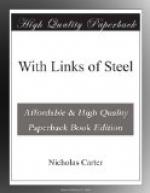Yet to the eyes of a layman they had all the qualities of natural gems, gleaming and glistening with magnificent fire in the cheerful sunlight of Nick’s library.
Pylotte had invented a very clever and consistent story about himself and his mission in New York, as well as about the meeting and being victimized by the counterfeit diamond shover, and Nick as yet saw no occasion for seriously distrusting him, or connecting him with the Kilgore gang.
He rather suspected, in fact, that Pylotte had shadowed the swindler, whom Nick felt sure was Kilgore, with a view to learning just how the diamonds had been manufactured, and possibly with a design to turn the discovery to his own advantage.
This was, indeed, the most natural deduction for Nick to arrive at, after considering all the circumstances.
“So you are confident that these stones are works of art, rather than of nature, are you?” inquired Nick, who had been carefully examining the gems.
“I am absolutely sure of it, Mr. Carter,” declared Pylotte.
“Have you any idea how such counterfeits can be made?”
“Oh, yes.”
“By what process and means, Mr. Pylotte?”
Pylotte hastened to explain.
“A natural diamond, Mr. Carter, is pure carbon, crystallized under enormous heat and pressure in the bowels of the earth.”
“I am aware of that.”
“Charcoal and graphite are also pure carbon, but not in a crystallized condition,” continued Pylotte. “If that condition could be imparted to the substances mentioned, we should have the artificial diamond.”
“How may that be done?” inquired Nick.
“By subjecting the substance to the same condition under which the natural diamond was crystallized.”
“Heat and pressure?”
“Precisely,” bowed Pylotte. “Attempts to thus manufacture diamonds have frequently been made. A Mr. Acheson, of Pittsburg, while so engaged, and in obtaining graphite from coal by the heat of an electric furnace, discovered that combination of silicon and carbon now known as carborundum, which has commercial value as an abrasive.”
“I know about that,” bowed Nick.
“Now, then,” continued Pylotte, with an unconscious display of enthusiasm; “while diamonds certainly have been made by artificial means, the great difficulty has been that of producing them at a low cost. Moissan, in my country, produced diamonds by heating charcoal and iron to a high degree, and letting the mixture cool under enormous pressure. He succeeded in obtaining very small crystals, or diamonds, but the cost of production made his method impracticable from a commercial standpoint.”
“Ah! I see.”
“In 1872 a chemist named Rose converted graphite into diamonds by a similar process, but with the same result.”
“The cost of production being too great?” observed Nick.
“Precisely.”




